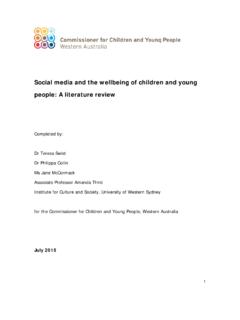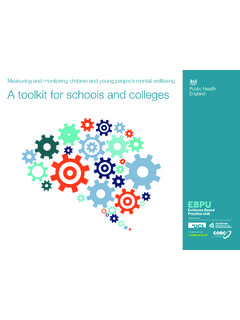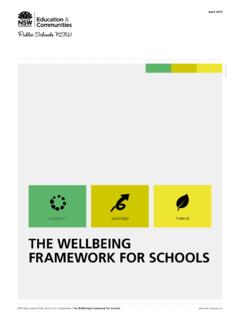Transcription of The power of music: its impact on the intellectual, social ...
1 The power of music: its impact on the intellectual , social and personal development of children and young people Susan Hallam, Institute of Education, University of London Executive Summary Recent advances in the study of the brain have enhanced our understanding of the way that active engagement with music may influence other activities. The cerebral cortex self- organises as we engage with different musical activities, skills in these areas may then transfer to other activities if the processes involved are similar. Some skills transfer automatically without our conscious awareness, others require reflection on how they might be utilised in a new situation. Perceptual, language and literacy skills Speech and music have a number of shared processing systems. Musical experiences which enhance processing can therefore impact on the perception of language which in turn impacts on learning to read.
2 Active engagement with music sharpens the brain's early encoding of linguistic sound. Eight year old children with just 8 weeks of musical training showed improvement in perceptual cognition compared with controls. Speech makes extensive use of structural auditory patterns based on timbre differences between phonemes. Musical training develops skills which enhance perception of these patterns. This is critical in developing phonological awareness which in turn contributes to learning to read successfully. Speech processing requires similar processing to melodic contour. Eight year old children with musical training outperformed controls on tests of music and language. Learning to discriminate differences between tonal and rhythmic patterns and to associate these with visual symbols seems to transfer to improved phonemic awareness. Learning to play an instrument enhances the ability to remember words through enlargement of the left cranial temporal regions.
3 Musically trained participants remembered 17% more verbal information that those without musical training. children experiencing difficulties with reading comprehension have benefitted from training in rhythmical performance. Numeracy 1. Research exploring the relationships between mathematics and active musical engagement has had mixed results, in part, because not all mathematics' tasks share underlying processes with those involved in music. Transfer is dependent on the extent of the match, for instance, children receiving instruction on rhythm instruments scored higher on part-whole maths problems than those receiving piano and singing instruction. intellectual development Learning an instrument has an impact on intellectual development, particularly spatial reasoning. A review of 15 studies found a strong and reliable' relationship, the author likening the differences to one inch in height or about 84 points on standardised school tests.
4 A study contrasting the impact of music lessons (standard keyboard, Kodaly voice) with drama or no lessons found that the music groups had reliably larger increases in IQ. children in the control groups had average increases of points while the music groups had increases of 7 points. On all but 2 of the 12 subtests the music group had larger increases than control groups. General attainment and creativity There is a consistent relationship between active engagement in music and general attainment but much research has been unable to partial out confounding factors. A recent study, adopting more sensitive statistical modelling overcame these difficulties. Two nationally representative data sources in the USA with data from over 45,000 children found that associations between music and achievement persisted even when prior attainment was taken into account. Music participation enhances measured creativity, particularly when the musical activity itself is creative, for instance, improvisation.
5 Personal and social development General attainment may be influenced by the impact that music has on personal and social development. Playing an instrument can lead to a sense of achievement; an increase in self- esteem; increased confidence; persistence in overcoming frustrations when learning is difficult; self-discipline; and provide a means of self-expression. These may increase motivation for learning in general thus supporting enhanced attainment. Participating in musical groups promotes friendships with like-minded people; self- confidence; social skills; social networking; a sense of belonging; team work; self-discipline;. a sense of accomplishment; co-operation; responsibility; commitment; mutual support;. bonding to meet group goals; increased concentration and provides an outlet for relaxation. Research in the USA on the benefits of band participation found that 95% of parents believed that participation in band provided educational benefits not found in other classrooms.
6 Working in small musical groups requires the development of trust and respect and skills of negotiation and compromise. In adolescence music makes a major contribution to the development of self-identity and is seen as a source of support when young people are feeling troubled or lonely. 2. Music has been linked to the capacity to increase emotional sensitivity. The recognition of emotions in music is related to emotional intelligence. Increasing the amount of classroom music within the curriculum can increase social cohesion within class, greater self-reliance, better social adjustment and more positive attitudes, particularly in low ability, disaffected pupils. The positive effects of engagement with music on personal and social development will only occur if, overall, it is an enjoyable and rewarding experience. The quality of the teaching, the extent to which individuals perceive that they are successful, and whether in the long term it is a positive experience will all contribute to the nature of any personal or social benefits.
7 Physical development, health and wellbeing Rhythmic accompaniment to physical education enhances the development of physical skills. Learning to play an instrument enhances fine motor co-ordination. There may be particular health benefits for singing in relation to the immune system, breathing, adopting good posture, improved mood, and stress reduction. The research has been carried out with adults but these benefits could equally apply to children . 3. The power of music: its impact on the intellectual , social and personal development of children and young people Introduction Recent advances in the study of the brain have enabled us to enhance our understanding of the way that active engagement with music influences other development. Although our knowledge of the way the brain works is still in its infancy some of the fundamental processes involved in learning have been established.
8 The human brain contains approximately 100 billion neurons a considerable proportion of which are active simultaneously. Information processing is undertaken largely through interactions between them, each having approximately a thousand connections with other neurons. When we learn there are changes in the growth of axons and dendrites and the number of synapses connecting neurons, a process known as synaptogenisis. When an event is important enough or is repeated sufficiently often synapses and neurons fire repeatedly indicating that this event is worth remembering (Fields, 2005). In this way changes in the efficacy of existing connections are made. As learning continues and particular activities are engaged with over time myelinisation takes place. This involves an increase in the coating of the axon of each neuron which improves insulation and makes the established connections more efficient.
9 Pruning also occurs, a process which reduces the number of synaptic connections, enabling fine-tuning of functioning. Through combinations of these processes, which occur over different time scales, the cerebral cortex self-organises in response to external stimuli and the individual's learning activities (Pantev et al., 2003). Extensive active engagement with music induces cortical re-organisation producing functional changes in how the brain processes information. If this occurs early in development the alterations may become hard-wired and produce permanent changes in the way information is processed ( Schlaug et al., 1995). Permanent and substantial reorganisation of brain functioning takes considerable time. Long years of active engagement with particular musical activities in Western classical musicians are associated with an increase in neuronal representation specific for the processing of the tones of the musical scale, the largest cortical representations being found in musicians playing instruments for the longest periods of time (Pantev et al.)
10 , 2003). Changes are also specific to the particular 4. musical learning undertaken (Munte et al., 2003). Processing of pitch in string players is characterised by longer surveillance and more frontally distributed event-related brain potentials attention. Drummers generate more complex memory traces of the temporal organisation of musical sequences and conductors demonstrate greater surveillance of auditory space (Munte et al., 2003). Compared with non-musicians, string players have greater somatosensory representations of finger activity, the amount of increase depending on the age of starting to play (Pantev et al., 2003). Clearly, the brain develops in very specific ways in response to particular learning activities and the extent of change depends on the length of time engaged with learning. The extent of musical engagement and its nature will be important factors in the extent to which transfer can occur to non-musical activities.




